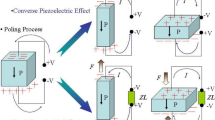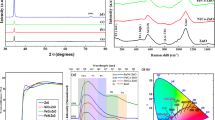Abstract
Process optimization and properties of lead zirconate titanate (PZT) films for piezoelectric micromachined ultrasonic transducers (pMUTs) for scanning probe devices will be presented. The goal of the work was a replacement of the tetragenic and mutagenic solvent and a decrease of time-consuming PZT 2–methoxy ethanol (2MOE) route. An alternative diol-based solution synthesis process was developed and “Design Of Experiment” (DOE) was used to achieve processing optimization for thick and crack free films. Tight parameter control allowed to develop a highly reproducible PZT diol process. The crystallization behaviour of crack-free PbZr0.53Ti0.47O3 films (1–5 μm) with oriented perovskite structure was examined by X-ray diffraction and surface analysis using scanning electron microscopy. Piezoelectric and dielectric properties were examined. The effective transverse piezoelectric coefficient e 31,f of sol–gel processed films was investigated for 4 μm thick layers. Best properties were achieved with {1 0 0}-textured films, where a remanent e 31,f value of −7.3 C/m2 was measured for 4.1 μm thick films.





Similar content being viewed by others
References
P. Muralt, Ferroelectric thin films for micro-sensors and actuators: A review, J. Micromechanics Microengineering 10, 136–146 (2000)
Y. Miyahara, PZT cantilever for non-contact atomic force microscopy. Appl. Surf. Sci. 140, 428–431 (1999)
P. Muralt, PZT thin films for microsensors and actuators: where do we stand? IEEE Trans. Ultrason. Ferroelectr. Freq. Control. 47(4), 903–915 (2000)
P. Muralt, et al., Study of PZT coated membrane structures for micromachined ultrasonic transducers. IEEE Ultrasonic Symposium. (2001) Atlanta.
M.-A. Dubois, P. Muralt, Measurement of the effective transverse piezoelectric coefficient e31,f of AlN and PZT thin films. Sens. Actuators. A 77(2), 106–112 (1999)
R.W. Schwartz, Chemical solution deposition of perovskite thin films. Chem. Mater. 9, 2325–2340 (1997)
D.V. Taylor, et al., Thickness Dependence of Electrical and Electromechanical Properties of Sol-gel Derived PZT Thin Films. in Electroceramics V. (European Ceramic Society, Aveiro, Portugal, 1996)
T. Tani, D.A. Payne, Lead oxide coatings on sol-gel-derived lead lanthanum zirconium titanate thin layers for enhanced crystallization into the perovskite structure. J. Am. Ceram. Soc. 77(5), 1242–1248 (1994)
K.G. Brooks, et al., Orientation of rapid thermally annealed lead zirconate titanate thin films on (111) Pt substrates. J. Mater. Res. 9, 2540–2553 (1994)
A. Seifert, et al., Processing optimization of solution derived PbZr1–xTixO3 thin films for piezoelectric applications. Integr. Ferroelectr. 35(1–4), 159–166 (2000)
P. Muralt, et al., Texture control of PbTiO3 and Pb(Zr, Ti)O3 thin films with TiO2 seeding. J. Appl. Phys. 83(7), 3835–3841 (1998)
N. Ledermann, P. Muralt, et al., {1 0 0}-Textured, piezoelectric Pb(Zrx,Ti1-x)O3 thin films for MEMS:integration, deposition and properties. Sens. Actuators, A. 105, 162–170 (2003)
K.D. Budd, S.K. Dey, D.A. Payne, Sol-gel processing of PT, PZ, PZT and PLZT thin films. Br. Ceram. Proc. 36, 107 (1985)
M.L. Calzada, R. Sirera, F. Carmona, B. Jimenez, Investigations of a diol-based sol-gel process for the preparation of lead titanate materials. J. Am. Ceram. Soc. 78(7), 1802–1808 (1995) JUL
Y.L. Tu, M.L. Calzada, N.J. Phillips, S.J. Milne, Synthesis and electrical characterization of thin films of PT and PZT made from a diol-based sol-gel route. J. Am. Ceram. Soc. 79(2), 441–448 (1996) FEB
G.E.P. Box, N. Draper, Empirical Model Building and Response Surfaces. Wiley Series in Probability and Mathematical Statistics. (Wiley, New York, 1987), (ISBN 0-471-81033-9)
Acknowledgements
The authors gratefully acknowledge the support of the Ceramic Laboratory from STI/IMX/EPFL for technical support and dielectric measurements.
This work was supported by the European FP6––STREP project MUSTWIN no. NMP2-CT-2003-505630.
Author information
Authors and Affiliations
Corresponding author
Rights and permissions
About this article
Cite this article
Gentil, S., Kohli, M. & Seifert, A. PZT thick films by diol chemical solution deposition. J Electroceram 19, 307–310 (2007). https://doi.org/10.1007/s10832-007-9053-2
Received:
Accepted:
Published:
Issue Date:
DOI: https://doi.org/10.1007/s10832-007-9053-2




